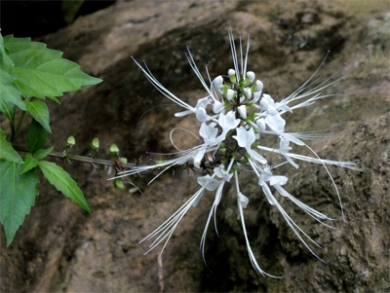Many people are familiar with the carambola, but a close relative, the bilimbi [Averrhoa bilimbi], possibly originating on the Moluccas, Indonesia, is cultivated in Indonesia, the Philippines, Sri Lanka, Bangladesh, Myanmar and Malaysia for its interesting acid fruits.

Photo: Internet
English: cucumber tree or tree sorrelIndia bilimbi
Sri Lanka: Bilincha, bimbiri
Dominican Republic: Vinagrillo
Philippines: kamias,kalamias, iba
Malaysia: belimbing asam, belimbing buloh, b’ling, billing-billing
Indonesia: belimbing wuluh, belimbing sayur
Thailand: taling pling, kaling pring
Vietnam: khế tàuHaiti blimblin
Jamaica: bimbling plum
Cuba: grosella china
El Salvador & Nicaragua: mimbro
Costa Rica: mimbro, tirigur
Venezuela: vinagrillo
Surinam and Guyana: birambi
Argentina: pepino de Indias
South India/Kerala: Bilimbi, Irumban Puli, Chemmeen Puli
France: carambolier bilimbi, cornichon des Indes

HortPark, Singapore, 20120323
Small, fragrant, 5-petalled flowers, yellowish-green or purplish marked with dark-purple, are borne in small, hairy panicles emerging directly from the trunk and oldest, thickest branches and some twigs, as do the clusters of curious fruits.

[Photo: HortPark, Singapore, 20120323]
Food Uses
The bilimbi is regarded as too acid for eating raw. They yield 44.2% juice having a pH of 4.47, and the juice is popular for making cooling beverages on the order of lemonade.
Mainly, the bilimbi is used in place of mango to make chutney. To reduce acidity, it may be first pricked and soaked in water overnight, or soaked in salted water for a shorter time; then it is boiled with much sugar to make a jam or an acid jelly. The latter, in Malaya, is added to stewed fruits that are oversweet. Half-ripe fruits are salted, set out in the sun, and pickled in brine and can be thus kept for 3 months. The flowers are sometimes preserved with sugar.
Other uses of the Fruit.
Very acid bilimbis are employed to clean the blade of a kris (dagger), and they serve as mordants in the preparation of an orange dye for silk fabrics. Bilimbi juice, because of its oxalic acid content, is useful for bleaching stains from the hands and rust from white cloth, and also tarnish from brass.
Medicinal uses:
In the Philippines, the leaves are applied as a paste or poulticed on itches, swellings of mumps and rheumatism, and on skin eruptions.
Elsewhere, they are applied on bites of poisonous creatures.
Malayans take the leaves fresh or fermented as a treatment for venereal disease. A leaf infusion is a remedy for coughs and is taken after childbirth as a tonic. A leaf decoction is taken to relieve rectal inflammation. A flower infusion is said to be effective against coughs and thrush.
In Java [Indonesia]: The fruits combined with pepper are eaten to cause sweating when people are feeling “under the weather”. A paste of pickled bilimbis is smeared all over the body to hasten recovery after a fever. The fruit conserve is administered as a treatment for coughs, beri-beri and biliousness. A sirup prepared from the fruit is taken as a cure for fever and inflammation and to stop rectal bleeding and alleviate internal hemorrhoids.
Source:
Wikipedia
http://www.ag.purdue.edu/HLA/Pages/ default.aspx
1.436046
103.786057




















